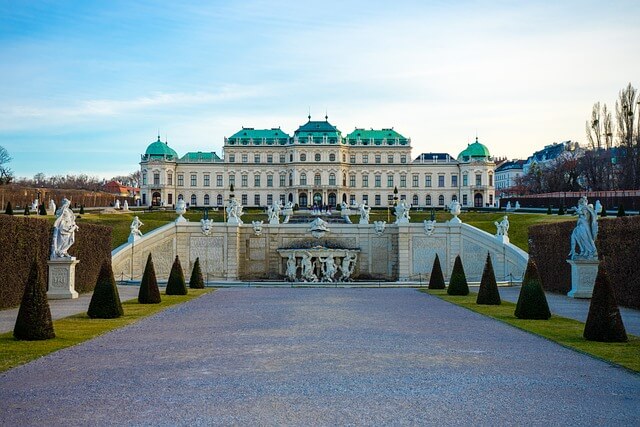Vienna Weather – A General Overview
Vienna, the beautiful capital of Austria, sits right in the heart of Europe. You’ll find it nestled near the Danube River in the northeastern part of the country. It’s not surrounded by towering mountains and isn’t at a high elevation itself. The various parts of the city range from 150 to 484 meters above sea level. The city and its surrounding areas are known for their lovely hilly landscapes, mountain peaks (like Kahlenberg Mountain, for example), forests, small lakes, and even a marshy region.
Generally speaking, Austria enjoys four distinct seasons, much like many other countries. The summer months bring warm (and sometimes even very hot) weather with some rain, while winter months are cold but typically quite dry. In summer, temperatures can reach up to a sizzling (so a hotel with air conditioning is definitely a good idea!), but usually, temperatures are comfortable, averaging around . In winter, temperatures drop and hover around . Snow does fall occasionally, but not usually in huge amounts. Spring in Vienna is pretty short (April and May) and can be quite changeable and rainy. Autumn, on the other hand, offers pleasant temperatures, and the amount of rainfall isn’t quite as high.
Vienna isn’t an exceptionally rainy city. Throughout the year, about of rain falls here. Interestingly, the rainiest season is actually during the summer months. In winter, the city can feel a bit gloomy (thankfully, everything lights up beautifully for Christmas!). There are often windy days throughout the year. The months with the most hours of sunshine are May through September.
The highest temperature ever recorded in Vienna was , and the lowest was a chilly . Of course, these are extreme temperatures that you wouldn’t usually encounter.
When is the Best Time to Visit Vienna Weather-Wise?
The best time to visit Vienna, purely in terms of weather, is during the spring and autumn months. This means April and May, as well as September and October (which often coincides with holiday periods). During these months, temperatures are mild, and the number of rainy days isn’t particularly high. What’s more, these months tend to be less crowded with tourists, allowing you to plan your Vienna itinerary at a more relaxed pace.
When is it Less Advisable to Visit Vienna Weather-Wise?
January and February are generally the least popular months for a visit to Vienna. During these months, temperatures are very low, hovering around or even below. Sunny days are also few and far between, and for most of the time, the skies are quite gray. This is a period with fewer tourists, and the city tends to be less active in terms of events and cultural activities.
What to Wear for a Trip to Vienna? Recommendations by Month
During the cold winter months (from late October to late March), temperatures hover around and even below. These are temperatures that might feel quite unfamiliar if you’re from a warmer climate. Therefore, during these months, it’s really important to pack warm clothing and multiple layers. Don’t forget a thick winter coat, gloves, a warm hat, a scarf or neck warmer, and waterproof walking shoes. Some travelers even bring hand warmers, which can be a fantastic solution if you’re spending a lot of time outdoors.
During the summer months (from June to late August), the weather is usually very pleasant. Throughout the day, you can typically stroll around in a short-sleeved shirt and shorts. It gets cooler in the evening, so it’s a good idea to bring some light but warmer clothing for the evening hours, including long pants. In the peak of summer, the heat in the city center might feel a little oppressive, so choosing a hotel with air conditioning is recommended.
In the autumn and spring months (September and October, April and May), the weather is changeable, meaning you could have cold days or warm and pleasant days. Because of this, it’s wise to bring a variety of clothes and dress in layers. A softshell jacket with a short-sleeved shirt underneath can be ideal for these months. And on the same trip, you might have days perfect for shorts and a t-shirt. So, during these transitional months, it’s worth packing both warmer clothing and lighter options.
Where to Check the Latest Weather in Vienna?
There are several websites that provide the most up-to-date weather information for Vienna. It’s important to remember that, generally, it’s tough to predict the weather far in advance. The best way to be truly prepared is to check the weather the day before your flight. That way, you’ll have the most accurate information. During the transitional seasons, surprising changes in weather can occur, so keep that in mind too.
Recommended Weather Websites for Vienna:
Detailed Weather by Month
In this section, you’ll find information on Vienna’s weather for each month of the year, based on typical averages.
Vienna in Summer
June The first month of summer in Vienna. It’s quite warm but not oppressively so. Temperatures usually range between and . It’s definitely lovely for being outdoors, and you can enjoy wonderful sunny days and summer attire throughout the day.
July July is considered the warmest month, and temperatures sometimes exceed . In this month, there can sometimes be extreme heatwaves that might reach . You can still walk around outside and even enjoy a swim in the Danube River. Generally, temperatures hover around .
August Temperatures become more moderate. August temperatures typically range between and . This is the last month of summer. At the beginning of August, it’s still very warm, but as the month draws to a close, temperatures gradually begin to cool.
Read about the best attractions in Vienna during the summer months

Vienna in Autumn
September Autumn begins in September, and with it comes a drop in temperatures. However, it’s still considered a pleasant and comfortable month for touring. Temperatures range between and . Definitely an ideal month for a trip to Vienna.
October Similar to September, early October still offers ideal temperatures for touring, but there’s a continuous cooling trend. Temperatures range between and .

Vienna in Spring
March The first part of March is more wintery and cold, and in the second part, it starts to warm up and become spring-like. Temperatures in this month range between and . March already has more hours of sunshine, though also many gray days.
April April is usually characterized by comfortable, spring-like weather, though it can be quite changeable. Every few years, snow falls in April, and it can be very cold. Likewise, there can be pleasant sunny days with . On average, temperatures range between and .
May The last month of spring, and temperatures are already more pleasant, making the weather ideal for touring. Temperatures range between and . Definitely ideal weather for walking tours. It’s still cool in the evening, so make sure to pack accordingly.

Vienna in Winter
November November is mostly cold and gray. Temperatures drop and range between and . In the second half of the month, the wonderful Christmas markets begin. For those not afraid of the cold, this is a wonderful time to enjoy a romantic winter atmosphere in the city.
December A wintery and cold month. Few hours of sunshine, if any, and also a possibility of snow (though rarely in large amounts). This is a month when the fantastic Christmas markets are active, which is why it’s considered a very beautiful month to visit the city. It’s important to dress warmly, as temperatures hover around in December.
January January is one of Vienna’s winter months. The weather is cold and sometimes snowy. The average temperature ranges between and . It is considered the coldest month in Vienna.
February February is the last month of the cold winter (although March can still be cold too!). Temperatures in this month range between and . Snow and rain days are possible.
Read about the best attractions in Vienna in winter

To Conclude
We truly hope this comprehensive overview of Vienna’s weather helps you arrive well-prepared for an enjoyable trip. You can find another 27 recommendations and tips for your trip to Vienna or Austria in general. Plus, if you haven’t chosen a hotel in the city yet, we’ve compiled a list of the most recommended hotels based on travelers‘ experiences. It’s worth checking out to find the ideal accommodation just for you.


















